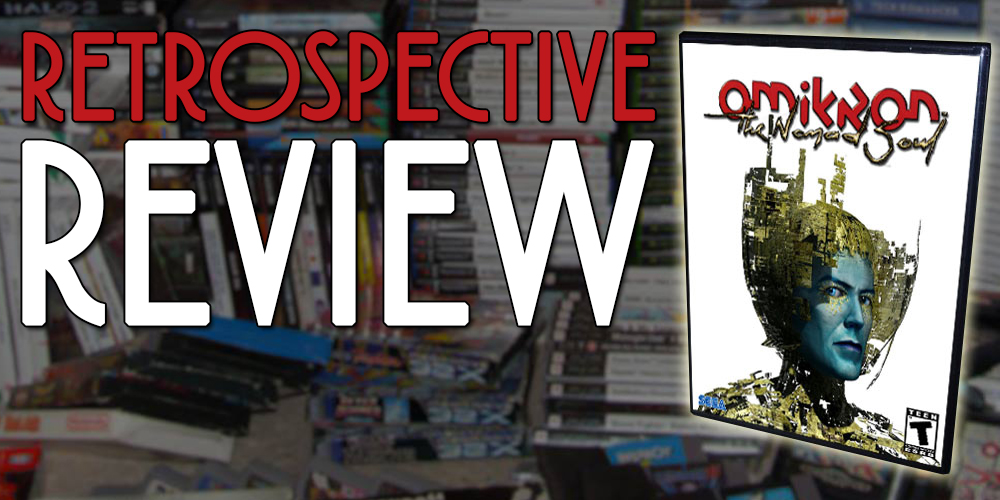
The passing of David Bowie in early 2016 was a death that shook the music industry. A pillar of rock ‘n’ roll and pop for over 50 years, it was a shock to many, and he will most definitely be missed. It was during this period that as a sign of respect and as a tribute to Bowie, Square Enix released a game called Omikron: The Nomad Soul as a free download for a limited amount of time. Originally released in 1999 for the SEGA Dreamcast and PC, Omikron is another David Cage creation (best known for Fahrenheit and Heavy Rain) involving a fine line of differing game genres.
What does that have to do with David Bowie, you may ask? Bowie was quite involved in the development of Omikron, originally being the game’s composer. He ended up having a lot more input, though and contributed to the storyline and even the game mechanics. Over all that, he played the part of two characters in-game and was motion captured for each role.
I, like many, took the opportunity of the free download since I’m a huge fan of Bowie but also enjoy David Cage games. It sadly occupied my shame pile for a while but after recently re-listening to Bowie’s final album, Blackstar (give it a listen – amazing album) I was encouraged once again to give Omikron a whirl.

This is a game which really likes breaking the fourth wall. In fact, the premise of the story is based on the idea. The game’s setting – which is an open and explorable world – is a city called Omikron. The nomad soul is you. And I don’t mean you as in the character you play in-game, but you you. The real you. The you sitting in your boxer shorts on a Sunday morning playing Dark Souls while contemplating which Skittles really taste like their colour.
Anyway, it starts with a police officer (and the first character you ‘control,’ but more on that in a second) named Kay’l 669 who pops his head through a portal from his dimension to ours asking for help. Not much else is really explained before your ‘soul’ starts controlling Kay’l – as the game basically thrusts you right into Kay’l’s dimension without much of a hint of what to do next. There is a rocking Bowie track played over some opening credits, however, but from there you’re on your own and free to start exploring the mean streets of Omikron.
It’s kind of cool how the game just dumps you into the world and then leaves you to your own devices. I should stress that you do very much find out what’s going on as you progress, so don’t let the concept put you off. Everything has been setup with the pretence that you yourself (in real life, Skittles or not) have abruptly left this dimension and have landed in some foreign, strange place without much understanding of what’s going on. It’s up to you, for reals, to find your own way.
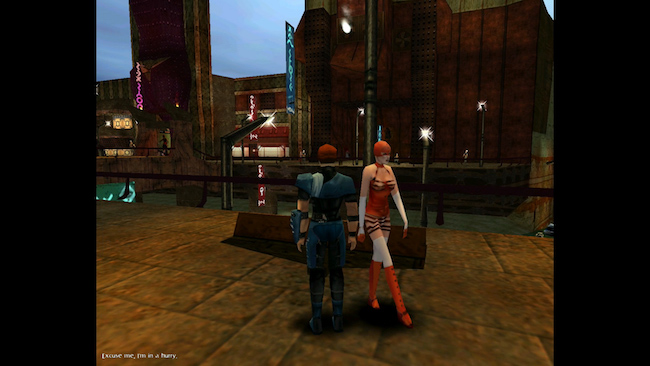
It’s because of this, that I don’t really want to spoil the plot too much as it’s that and the environments setting that really makes this game shine. In a nutshell, though, as you start controlling Kay’l you realise you’re in the midst of an investigation of a serial killer, and your partner has just conveniently bitten the dust as the blame not so subtlety falls on you.
This is not a late-’90s David Bowie infused L.A. Noire, however, as you soon realise that the serial killer is in fact… a demon! Even the head of the police department is a demon (pretending to a meaty flesh-bag of a human) who orchestrated your ‘soul’ coming to Omikron (by tricking poor Kay’l) so he can do who knows what with it.
Oh, and did I mention that the city of Omikron is in a big dome because the planet it resides on is in an ice-age and that the totalitarian government that oversees it is run by a supercomputer? No? Well, those are things of note, too. And believe it or not, there is even more. It may seem like I’ve just wholly explained the story and even let rip some spoilers, but trust me, it goes even deeper. So, for the sake of this reviews length and anyone who may want to play it, I’ll leave it right there. Let’s get into how Omikron actually plays.
Since you are a soul with nomad tendencies, you’re not restricted to just poor, old Kay’l. If he crunches the nut, it’s very possible that instead of there being a respawn, your soul will just simply travel into some other poor bastard (being controlled by one of our souls seems to end badly for most if you hadn’t already figured). This was certainly not the last time that David Cage would explore mortality in-game either. What instantly springs to mind is Heavy Rain (released in 2010), but since your very soul is at risk this time around, it’s certainly a big aspect of the storyline.
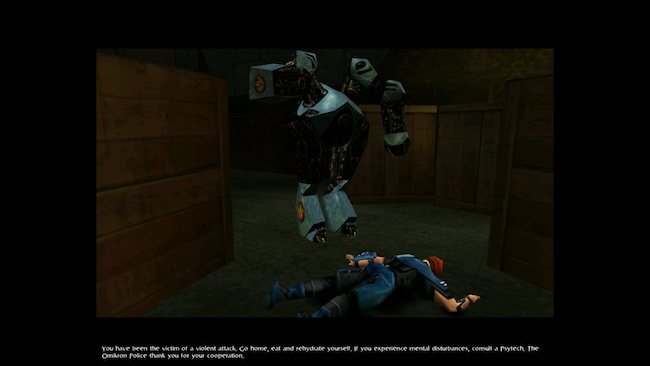
As an adventure game at heart, you direct whoever you’re controlling via soul around the expansive environments while interacting with people and objects. There are many items scattered around that can be picked up and kept, although not all of them are useful. Some are general use, like ammo or health, while other items like newspapers tell the story of Omikron. Of course, though, there are objects that are essential to continuing the story, and it’s up to you to figure out how they fit in. You might need to present them to someone else for example, or they may interact with the environment at large somehow. Items can also be combined in the inventory screen, too, adding a further layer to the puzzle component.
Sadly, the inventories capacity is limited which may stop you from knicking everything that’s not bolted down. However, there are computer terminals scattered around where excess items can be stored. If it truly is worthless crap, though, and you wish to never see it again, you can either just delete it or even sell it to the bank at a questionable rate.
The adventure aspect is certainly the biggest in the game, and while enjoyable it’s rare that I got stuck on what to do next. As long as you pay attention and read and explore as much as you can, you won’t be left confused. I understand that this gameplay style won’t be for everyone – but then again, whenever is it for a David Cage game?
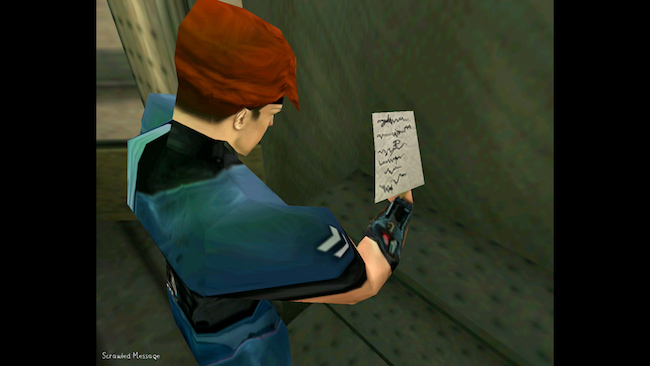
Communicating with others in-game is essential, too, so don’t just skip through the conversation tree like a dodgy freeware installation. You might not accidently agree to download any unwanted malware, but you will miss out on important and vital information. Additionally, how you choose to speak dictates the storyline. If you’re a narky no-gooder, it will reflect in the game.
There are a few other gameplay genres mixed in to keep you guessing, too. Remember how I said ammo was a pick-up? That’s because there are levels thrown in which suddenly change Omikron into an FPS. I say thrown in, too, because they kind of feel like a last minute addition to the development process. The view will switch from the 3rd person to the 1st, and you’ll suddenly be running around shooting fools. These sections are straight up awkward to control as well, as the default keyboard layout chooses the mouse to aim but the arrow keys to move like in the adventure mode. Luckily, this can be changed to the more standard WASD in the menu, but it’s certainly an odd design choice.
These levels are usually in cramped spaces where most of the enemies are hiding behind walls at right angles to you, or far enough away that the game’s draw distance can’t keep up. You can’t see them, but they can certainly see you which leads to frustrating situations where you’re being shot at, but you can’t tell from where. Over that, enemies will spawn randomly behind you and shoot you in the back even though you just thought you cleared the area and moved on.
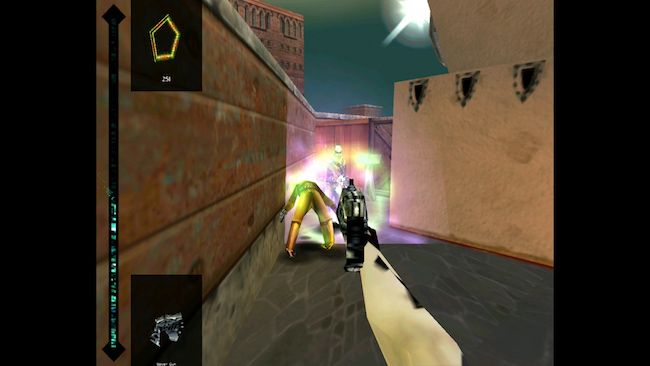
As you can probably tell, I wasn’t a big fan of the FPS parts, but the one on one fighting sections are a bit better. These suddenly switch the game to a fighting genre instead of adventure or FPS, a la Street Fighter or Mortal Kombat, and are luckily a bit more polished. There are moves to be learned and the default controls feel a lot more natural, but sadly this goes to waste a bit since you can just spam a kick or whatever until you win. Not the way it should be played, I know, but usually I was just eager to get back to the adventure mode.
Now, let’s discuss the saving system. To save game progress there are these magic rings that must be collected which get used up every time you choose to save – and these are seemingly a rare commodity comparable to Spanish Doubloons. A finite resource, to say the least.
I do not condone cheating, let’s get that out of the way. Why screw yourself out of your investment and time by cheating? Having said that, though – I believe there are exceptions to the rule and being able to control when you can use predetermined save points included with the game is one of those. I’m a modern 21st-century man with modern 21st-century values, and the general requirements of being as such means that I sometimes can’t keep playing in an indefinite fashion until some magic rings show up.
So yes, I used a cheat patch to bump up my magic rings supply. Shoot me if you think that goes against some sacred gaming code or what have you. But I’d argue that playing Omikron with its usual save system is an unreasonable endeavor for anyone that works or studies full time, and is one of the main Debbie-downers of the game.
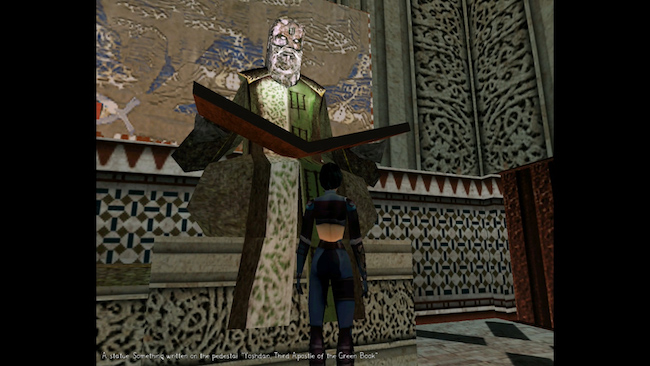
The city of Omikron and the various other locals included are beaming with a surprising amount of life considering the games age. Sure, there are plenty of graphical aspects that are dated, but if you can look past the blocky graphics and not so high-resolution graphics, you’ll see that this game has a lot of style. From futuristic visuals with undertones of suppression and melancholy to environments that are teeming with gothic horror – Omikron sure looks distinctive.
The sound design falls into this boat, too, by being again, distinctive but also by being memorable and original. I’d expect nothing less for a soundtrack designed by Bowie himself, and this game acts as further proof of the extensive creative skillset he held. Just like the visuals, it’s sort of spooky but also totally draws you in.
Bowie did acting as well as singing – check out a ’70s movie called The Man Who Fell to Earth if you ever have two and half hours to spare – and as before mentioned played the part of two characters in-game. While not arguably the best voice actor of all time, he still accomplished an admirable performance and seeing him as a video game character never gets old. The rest of the spoken dialogue wasn’t too bad either, although there isn’t too much of it. I guess sacrifices with the audio had to be made considering its age.
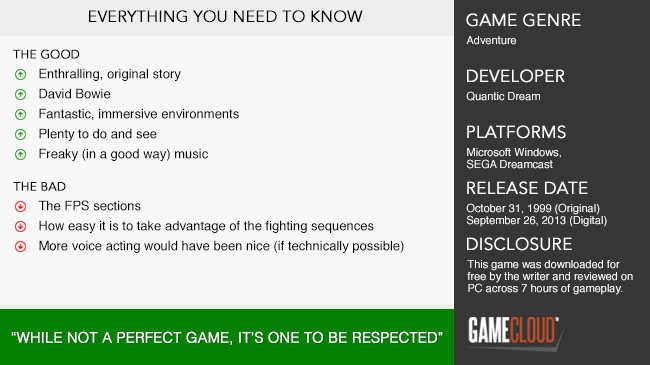
While not a perfect game, Omikron: The Nomad Soul certainly tries to do a lot and this should be somewhat admired. It doesn’t get everything right – and some of what it does get wrong it really half-arsed (like the shooting sections). But overall, this is a game to be respected. The story is engrossing, the visuals and sound are distinctive (even if dated), and it really shines in the adventure segments. The two David’s really have got themselves quite a game here, and it sucks that it has been somewhat forgotten. A HD re-release certainly wouldn’t disappoint.











